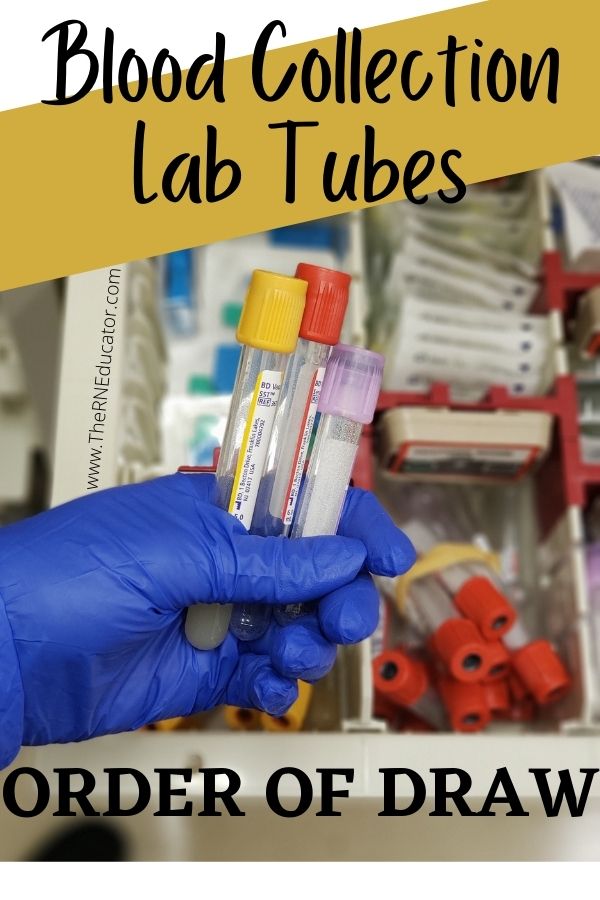Blood Collection Lab Tubes and Order of Draw

Let’s talk BLOOD COLLECTION LAB TUBES! Do you draw labs at your facility as a nurse or do you have a phlebotomy team that does it for you? Well, if you work somewhere nurses are responsible for collecting blood work then you might want to continue reading!
Today on The RN Educator we are talking laboratory tubes, the specific order in which you draw them and some common tests that you can run with each lab tube. It is very important to collect the proper lab tubes in their specified order due to the potential risk of skewed or affected results. Last thing you want to do is have to redraw a sample (especially if your patient is a hard stick!).
1. Blood Cultures
Contains: Aerobic or Anaerobic culture
Uses: Rules out Microorganisms in the bloodstream

Blood cultures should always be collected first to prevent the risk of any contamination from other tubes or additives.
What is the difference between Aerobic vs. Anaerobic cultures?
Aerobic microorganisms replicate in an oxygenated environment whereas, anaerobic microorganism thrive in reduce-oxygenated environments. I have a post all about blood culture collection. Learn all about blood culture bottles and how to properly collect them here.
2. Sky Blue lab tubes
Contains: Sodium Citrate
Uses: Coagulation tests, PT, PTT

This tube is collected when testing for coagulation studies such as Von Willebrand disease (most common blood clotting disorder), Clotting factors, D-dimer to rule out thrombosis, Anti factor Xa to monitor patients on high dose low molecular weight heparin, Prothrombin time, etc.
The additive inside the tube stops the blood from clotting.
3. Red lab tube
Contains: NO additive inside
Uses: Chemistry, immunology, Serology, blood bank

This tube is collected when you want to see chemistry such as a toxicology, specific drug levels, bacterial and viral serology, immunology such as antibodies and more.
There is no additive inside this tube which means it will allow the blood to clot naturally.
4. Gold lab tube
Contains: Serum Separating Tube (SST)
Uses: Chemistry, Endocrine,Serology, Immunology

This tube is collected when checking for biochemistry tests such as urea and electrolytes, C-reactive protein (CRP), amylase assay, iron studies, creatine kinase (CK), lipid profile (cholesterols), endocrinology studies such as growth or sex hormones, microbiology and virology tests such as HIV and immunology tests such as rheumatology, thyroid antibodies and immunoglobulin.
The additive in the gold tube contains two different agents. One of the agents is to clot the blood while the other agent separates the plasma from the blood cells. This makes it easy for lab to centrifuge the tube (spin it in a machine) and remove the separated plasma.
5. Dark Green lab tube
Contains: Sodium Heparin
Uses: Ammonia, Heparin levels, lithium levels

This tube is used a lot less commonly than the others but still used nonetheless. Tests such as heparin levels or lithium drug levels.
The additive inside this tube consists of sodium heparin which serves as an anticoagulant.
6. Light Green lab tube
Contains: Plasma Separating Tube
Uses: Genetics, Renin, aldosterone, Chemistry

This tube is not used very often but when it is it accompanies an order for routine biochemistry. However, the gold tube is used more frequently than this one.
The additive in this tube consists of two agents, lithium heparin, which serves as an anticoagulant of blood and plasma separator which separates plasma from the blood cells (just like the gold tube!)
7. Lavender lab tube
Contains:EDTA
Uses: Hematology, Cross Match

This tube is mainly collected when hematology studies. In a hematology tests, whole blood needs to be inspected therefore, common tests you will see with the lavender tube include but are not limited to complete blood count (CBC), Erythrocyte sedimentation rate (ESR), reticulocytes, Monospot test for Epstein Barre Virus (EBV), etc.
The additive in this tube serves as an anti-coagulant which stops blood from clotting.
8. Grey lab tube
Contains: Floride Oxalate
Uses: Lactate, Blood glucose

This tube is fairly easy to remember because it is used for very few things such as blood glucose, lactate and blood alcohol.
The additive it contains acts as an anticoagulant so blood does not clot and an antiglycolytic. This means it will NOT further breakdown any glucose from the blood to ensure an accurate blood glucose result.

Well, my friends! I hope you learned more than what you knew before about these lab tubes. You should now know the order to collect them in, when to use them and what additive is in each tube. This is extremely important when collecting blood because if you use the wrong tube your results can be greatly affected or simply not have the ability to run a test.
What experience do you guys have with lab tubes? Do you have any tips and tricks when collecting blood that you can share in the comments below? Do it!
’till next time,
The RN Educator
Share this:
Related Posts
What’s in a Pediatric Crash Cart? Nursing Students read NOW!
A pediatric crash cart is a mobile unit containing essential equipment and medications required for…
Share this:
How to Become a Confident Nurse
If you are anything like me, and let’s face it (like every nurse…



